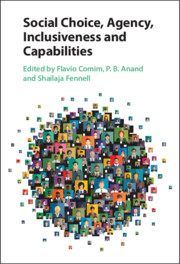Book contents
- Social Choice, Agency, Inclusiveness and Capabilities
- Social Choice, Agency, Inclusiveness and Capabilities
- Copyright page
- Contents
- Figures
- Tables
- Contributors
- Preface and Acknowledgements
- 1 Introduction: social choice, agency, inclusiveness and capabilities
- Part I Social Choice and Capabilities
- Part II Inclusiveness, Social and Individual Agency
- Part III Social Choice and Capabilities in Action
- 14 Measuring the independence of ‘dependent’ persons based on the capability approach
- 15 Indigenous challenges to the capability approach
- 16 Situating the family within the capabilities framework: a collective conversion factor
- 17 An ethical perspective on the United Kingdom’s Improving Lives: The Future of Work, Health and Disability
- 18 Public services as conversion factors
- Index
- References
16 - Situating the family within the capabilities framework: a collective conversion factor
The role of the household configuration in the quality of life in Mali
from Part III - Social Choice and Capabilities in Action
Published online by Cambridge University Press: 28 March 2024
- Social Choice, Agency, Inclusiveness and Capabilities
- Social Choice, Agency, Inclusiveness and Capabilities
- Copyright page
- Contents
- Figures
- Tables
- Contributors
- Preface and Acknowledgements
- 1 Introduction: social choice, agency, inclusiveness and capabilities
- Part I Social Choice and Capabilities
- Part II Inclusiveness, Social and Individual Agency
- Part III Social Choice and Capabilities in Action
- 14 Measuring the independence of ‘dependent’ persons based on the capability approach
- 15 Indigenous challenges to the capability approach
- 16 Situating the family within the capabilities framework: a collective conversion factor
- 17 An ethical perspective on the United Kingdom’s Improving Lives: The Future of Work, Health and Disability
- 18 Public services as conversion factors
- Index
- References
Summary
The familys economic and socio-cultural capital and how it is shared among its members influence a person’s capabilities and choices. This chapter posits that the family acts as a collective conversion factor, and presents a case study in Mali. A typology of household configurations that best expresses the diversity of family forms is built, then used to see the relation to the overall quality of life of household members, measured by goods (household assets) and opportunities (child education and women’s autonomy). The association between these configurations and children’s access to schooling, controlling for the household standard of living, is then considered, regression analysis results showing that access to education is correlated with the household standard of living, but there is also a household configuration net effect. Extended households seem better off and better suited to develop solidarity strategies that facilitate access to schooling. But the priority given to education also appears to play a role in differences between households, shown by a higher education rate of children in rural households headed by an educated man and in urban ones that are female-headed.
- Type
- Chapter
- Information
- Social Choice, Agency, Inclusiveness and Capabilities , pp. 356 - 384Publisher: Cambridge University PressPrint publication year: 2024

